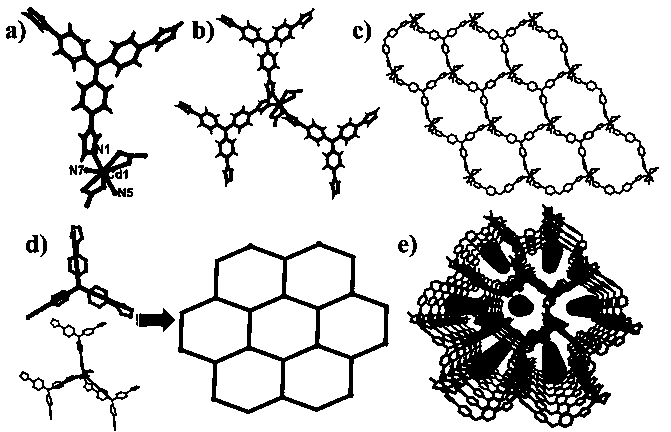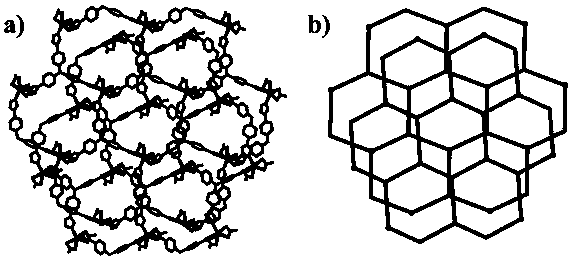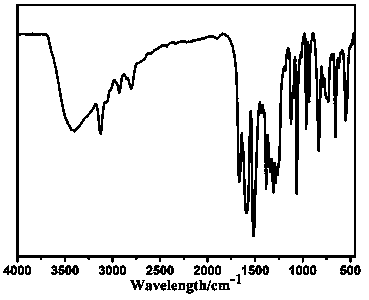Metal organic framework molecular material of electron-rich system and application thereof in photocatalytic reduction of heavy metal ions
A metal organic framework and heavy metal ion technology, applied in the catalytic reduction of heavy metal ions, especially in the application of Cr and Mn, in the field of new metal organic framework molecular materials, can solve the problems of secondary pollution, high cost, low efficiency, etc., and achieve high efficiency catalytic effect
- Summary
- Abstract
- Description
- Claims
- Application Information
AI Technical Summary
Problems solved by technology
Method used
Image
Examples
Embodiment 1
[0029] Synthesis method of a new type of double interpenetrating metal-organic framework molecular materials with electron-rich systems, including ligands and catalysts [Cd(TIPA) (NO 3 ) 2 ]·H 2 The synthesis of O specifically comprises the following steps:
[0030] 1) Synthesis of ligand tris-(4-imidazolylphenyl)amine (TIPA)
[0031] For details, please refer to the literature (S. Z. Luo, X. L. Mi, L. Zhang, et al. Functionalized chiral ionic liquids as highly efficient asymmetric organocatalysts formichael addition to nitrogens [J]. Angew Chem Int Ed., 2006, 45: 3093-3097.) synthesis.
[0032] 2) Compound [Cd(TIPA) (NO 3 ) 2 ]·H 2 Synthesis of O
[0033] The compound Cd-TIPA was prepared by self-assembly under hydrothermal conditions, specifically: weigh Cd(NO 3 ) 2 ·6H 2 O 42 mg (0.14 mmol), TIPA 23 mg (0.05 mmol) in a mixed solvent (the mixed solvent is composed of distilled water and N,N-dimethylformamide DMF with a volume ratio of 2:1), and stirred at room temper...
Embodiment 2
[0047] Example 2: Photocatalytic application experiment
[0048] Photocatalytic reduction of heavy metal ions: selection of potassium dichromate (K 2 Cr 2 o 7 ) and potassium permanganate (KMnO 4 ) as a Cr(VI) source and a Mn(VII) source for photocatalytic testing under visible light. The specific operation was as follows: 5 mg of the compound Cd-TIPA was dispersed in 5 mL of Cr(VI) or Mn(VII) aqueous solution with an initial concentration of 0.5 mol / L, and then the mixed solution was exposed to a 10 W white light lamp. After different irradiation times, the solutions were removed from the suspension and centrifuged to remove the catalyst for analysis. The photocatalytic process of the compound was studied by UV-Vis absorption spectroscopy.
[0049] Research on Photocatalytic Properties
[0050] At present, the reductive transformation from Cr(VI) to Cr(III) is the most promising method in the treatment of Cr(VI) pollution. Previous studies have shown that the increase ...
PUM
 Login to View More
Login to View More Abstract
Description
Claims
Application Information
 Login to View More
Login to View More - R&D
- Intellectual Property
- Life Sciences
- Materials
- Tech Scout
- Unparalleled Data Quality
- Higher Quality Content
- 60% Fewer Hallucinations
Browse by: Latest US Patents, China's latest patents, Technical Efficacy Thesaurus, Application Domain, Technology Topic, Popular Technical Reports.
© 2025 PatSnap. All rights reserved.Legal|Privacy policy|Modern Slavery Act Transparency Statement|Sitemap|About US| Contact US: help@patsnap.com



